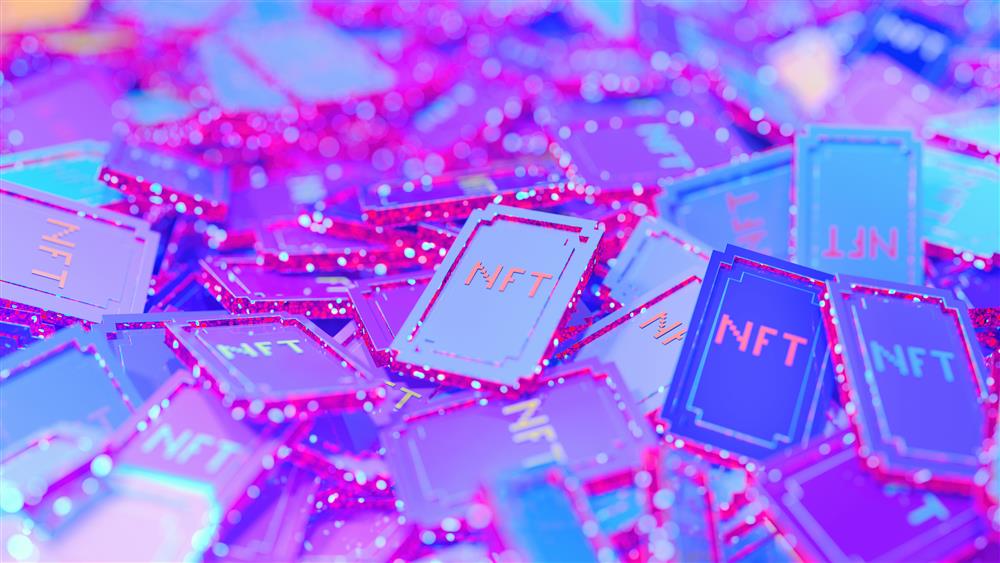NFTs: Their Effect on the Entertainment Industry
5 Min. Read

Part 1 of 3
When a digital piece of art was sold by Christies, the British auction house, for $69 million in March 2021, Non-Fungible Tokens (NFTs) suddenly became popular. What it was selling was an NFT, a cryptocurrency token that certifies a buyer is the owner of a unique one-of-a-kind work of art, song, or other product. It is important to note that an NFT is not what it depicts. NFTs allow us to tokenize digital or real-world assets, such as art, collectibles, or even real estate. NFTs can only have one owner at a time and can’t be altered or forged. Stored on blockchain network, they act as verifiable proof of authenticity and ownership. In recent months, NFTs have included tweets, basketball dunk videos, memes and even the source code for the internet.
According to DappRadar, in 2022 the NFT market produced over $24.7 billion in organic trading volume across blockchain platforms and marketplaces. Forbes projects that by 2030, the NFT market will be worth $231 billion. That is a tenfold increase, yet many people are unaware of what they are.
NFT supporters claim that they resolve a challenging issue with digital art; how to own an original. The concept of an original is challenging to define for creators who sell their work as exact replicas or freely share their work online. Since digital files may be freely shared online, exclusivity cannot be enforced. Collectors, however, desire the prestige that comes with owning an exclusive claim to a work of art. This is where NFTs come into play.
NFT avatars are the most popular application for digital artwork collectors. NFT avatars took off in 2021 and can command up to millions of dollars per image. These exclusive pieces of digital artwork are popular among celebrities who collect and utilized them as profile images on social media. Owning an NFT avatar is considered a sign of prestige and often grants entry into exclusive membership clubs.
Among the most popular creators today of NFT avatars are CryptoPunk and Bored Ape Yacht Club (BAYC). BAYC is a collection of 10,000 unique Bored Ape NFTs— unique digital collectibles living on the Ethereum blockchain. The more unique the attributes on the ape (i.e.: clothes, eyes, hair…accessories) the more valuable. Among the largest NFT marketplaces for buying and selling these digital collectibles are Opensea, Rarible, and Binance.
NFTs in Entertainment & Media:
As NFTs have started taking over the digital world, they are also ushering in a new era for the entertainment industry. Through NFTs, the entertainment industry is finding innovative ways to increase revenues, raise capital, engage audiences, and power the fan economy
Digital art was the beginning, followed by games and the music sector, and now television and film. With a wealth of intellectual property and devoted fan bases, it should come as no surprise that the entertainment industry is starting to take advantage of the NFT market. Opportunities abound.
NFTs could create a brand-new funding channel that would aid producers in overcoming financial limitations. For instance, movie NFTs might enable a director to transfer ownership of their upcoming movie to potential viewers while simultaneously generating the required funding. Buying such NFT may even give the buyer "producer" credit for the movie. This connection would improve both the fundraising process and the fan experience, enabling viewers to participate actively in the entire filmmaking process.
NFTs might make it easier for A-list studios like Disney and Warner Bros. to create mixed-reality storytelling like theme parks that offer a blend of digital and real-world experiences or grant virtual access to red-carpet events to loyal fans from around the world. Then there’s the exclusive access to vintage movie scenes, pages from a script, and, of course, digital artwork with all your favorite actors.
Use Case: NBA Top Shot
The NBA Top Shot is a prime example of how NFT’s are fueling the fan economy. Since it’s 2020 debut, the partnership between the National Basketball Association (NBA) and non-fungible titan Dapper Labs has grown dramatically. The reason is clear: Top Shot established a location where people with an interest in NFTs, collectibles, and — most importantly — basketball could come together to exchange artifacts of NBA sports history. In this way, NBA Top Shot has helped basketball fans feel more connected to their favorite sports teams, athletes, and moments in sports.
The NBA licenses its game reels to Dapper Laps, who in turn digitizes the footage, making a limited amount to create scarcity. NBA Top Shot NFTs feature significant "Moments" that were created on the FLOW blockchain. Moments are game highlights from videos. Like conventional trading cards, moments are created in "packs” and vary in rarity. There are four kinds of moments: 1) Common Moments (widely available, largest edition size) 2) Fandom Moments (flexible edition sizes, designed to celebrate your fandom), 3) Rare Moments (smaller edition size, highly sought after) and 4) Legendary Moments (elite collector level, extremely rare). A Common Moment can sell for as little as $10. A Legendary Moment can sell for hundreds of thousands of dollars. LeBron James “Cosmic” Dunk NFT sold for $208,000. The hope is that in 20-30 years that same NFT is as valuable as a 1952 Tops Mickey Mantle card, worth $5.2 Million today.
The NBA and Dapper Labs licensing agreement allocates a percentage of all NFT sales to the league and its players. Effectively giving birth to a new business model allowing the NBA and its players to monetize its IP and benefit from ALL future transactions related to the sale of such IP.
Giving NBA fans a gamified experience is also among the project's goals. Users can participate in NBA Top Shot competitions and win rewards, moments and rare packs. The NBA TOP Shot is a slam dunk example of the successful use of NFT to expand revenues, engage audiences and power the fanbase.
More to Come
Although blockchain technology was initially developed as an innovative digital currency tool for the financial industry, all kinds of businesses are now testing its core functionality as a decentralized and secure ledger to manage digital assets more directly and to rethink how they compete in the market. Particularly in the entertainment and media sectors, where monetizing value has been and still is a big difficulty, a few new business models are emerging. Media conglomerates have already started staffing up inhouse blockchain technology labs to foster Web3.0 innovation. Stay tuned for our next feature, where we discuss another innovative use of blockchain technology, NFT Ticketing.

